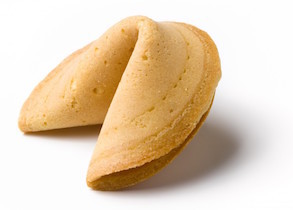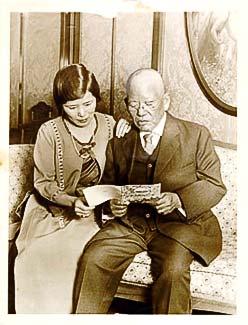The Disputed Origin of the Fortune Cookie
Fortune cookies accompany meals in Chinese restaurants, so they must be Chinese in origin, right? Not exactly.  Most cultural historians now think that the fortune cookie was an American invention, possibly by someone originally from Japan. Who that inventor was for sure is in dispute to this day. One tradition that Chinese people maintain for Chinese New Year is the giving of mooncakes that contain secret messages. Many people think that this is part of the story of the origin of the fortune cookie. The mooncake practice dates to the Ming Dynasty, which succeeded Kublai Khan's Yuan Dynasty and ruled China from 1368 to 1644. The secret messages in those cookies would have been passed from peasants to religious leaders and back, in part of a resistance movement. The fortune cookie is not a mooncake, however. Other historians point to a few bakeries in the neighborhood of a popular Shinto shrine outside Kyoto, Japan, that were making crackers that resemble today's fortune cookies in shape. Called an omikuji, this food was a bit larger and darker in color than fortune cookies; the ingredients were slightly different as well. Inside was a fortune, although the slip of paper on which the fortune was written was folded into the bend of the cookie, not in the hollowed out middle, as is the case with today's fortune cookies. Immigration into the United States by Chinese people swelled in the 19th Century, as workers came to build the Transcontinental Railroad and others came during the California Gold Rush. That state in particular had a large Chinese population, as much as 10 percent in the 1870s. Alarmed by the swell in Chinese immigration, Congress in 1882 passed the Chinese Exclusion Act, which instituted severe restrictions on the ability of Chinese people to find manual labor jobs and become U.S. citizens. In response, many Chinese people went to work in restaurants and laundries. Japanese immigration into the United States increased after Commodore Matthew Perry's "opening" of Japan to world markets. Fewer Japanese people than Chinese people arrived on American shores, however. The number of Japanese immigrants was significant, though, and many of those people worked not only in manual labor jobs but also in service industries like restaurants. Japanese restaurant owners found that the American palette wasn't that fond of Japanese food, and so many Japanese people served in their restaurants not Japanese food but Chinese food.  In the late 19th or early 20th Century, two restaurant owners, one Chinese and the other Japanese, began serving fortune cookies in their eateries. David Jung of China founded the Hong Kong Noodle Company in Los Angeles. Jung's company says that Jung created the cookie in 1918, as something to hand out to poor people who wandered in the neighborhood near his shop. The slip of paper in Jung's cookies contained an inspirational Bible message, written by a Presbyterian minister.  About the same time, Makoto Hagiwara of Japan owned Yamatoya, a restaurant in San Francisco. Hagiwara was originally a landscape gardener; he designed the Japanese Tea Garden in San Francisco's Golden Gate Park. Hagiwara's company says that Hagiwara invented the cookie in 1914, as a treat to give to people who had supported him during a dispute with the city's mayor; inside each of Hagiwara's cookies was a thank-you note. Both versions of the invention of the fortune cookie have adherents and detractors. Neither has been conclusively proved as the single point of origin. Both companies made fortune cookies for many years. The idea spread throughout California and then throughout the U.S., particularly after World War II, after many American servicemen came back from the war, through California, where they encountered fortune cookies at Chinese restaurants. (Despite the possible Japanese influence on fortune cookies, the war against Japan soured many in America on things Japanese.) In the 21st Century, estimates are that 3 billion fortune cookies are made each year worldwide. Most of those are consumed in the United States. Wonton Food in Brooklyn, N.Y., makes 4.5 million fortune cookies each day. Some manufacturers produce their own fortune slips; other manufacturers outsource this element of production. Yang's Fortunes, based in San Francisco, produces 4 million paper fortunes a day. Many people in China do not consider the fortune cookie Chinese but, rather, an American version of a Chinese-influenced food. |
|
Social Studies for Kids
copyright 2002–2024
David White




